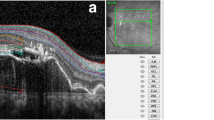Abstract
Purpose
To assess the change in the macular layers in the fellow eyes of unilateral retinal vein occlusion (RVO) patients and to evaluate whether certain layers are more affected based on RVO type.
Methods
This retrospective study included 87 fellow eyes of patients with unilateral RVO (26 central, 61 branch) and 105 eyes of 105 subjects without RVO. Spectral domain optical coherence tomography was used for automatized retinal segmentation. The thicknesses of retinal nerve fiber layer (RNFL), ganglion cells, inner plexiform, inner nuclear, outer plexiform, outer nuclear, photoreceptor layers, overall inner retinal layers and retinal pigment epithelium (RPE) were documented.
Results
Inner plexiform layer was thinner in inferior sector in RVO group compared with the control group (p = 0.047). The subgroup analysis showed that the retina was thinner in RVO group compared with the controls without systemic diseases in some sectors of the following layers: inferior retina, RNFL, ganglion cell layer, inner plexiform layer, inner retinal layers and RPE (p < 0.05). Retinal thickness was decreased in the fellow eyes of branch RVO group compared to that in the central RVO group in the some sectors (p < 0.05).
Conclusions
The fellow eyes of unilateral RVO patients did not show major structural differences compared with the controls; however, they revealed significant sectoral thinning in many retinal layers when compared with the eyes of healthy subjects without systemic diseases. Central macula was thinner in the fellow eyes of patients with branch RVO compared to that in central RVO.


Similar content being viewed by others
References
Coscas G, Loewenstein A, Augustin A, Bandello F, Battaglia Parodi M, Lanzetta P et al (2011) Management of retinal vein occlusion–consensus document. Ophthalmologica 226(1):4–28
Rogers S, McIntosh RL, Cheung N, Lim L, Wang JJ, Mitchell P et al (2010) International eye disease consortium. The prevalence of retinal vein occlusion: pooled data from population studies from the United States, Europe, Asia, and Australia. Ophthalmology 117(2):313–319
Green WR, Chan CC, Hutchins GM, Terry JM (1981) Central retinal vein occlusion: a prospective histopathologic study of 29 eyes in 28 cases. Trans Am Ophthalmol Soc 79:371–422
Frangieh GT, Green WR, Barraquer-Somers E, Finkelstein D (1982) Histopathologic study of nine branch retinal vein occlusions. Arch Ophthalmol 100(7):1132–1140
Klein R, Klein BE, Moss SE, Meuer SM (2000) The epidemiology of retinal vein occlusion: the Beaver Dam Eye Study. Trans Am Ophthalmol Soc 98:133–141
McIntosh RL, Rogers SL, Lim L, Cheung N, Wang JJ, Mitchell P et al (2010) Natural history of central retinal vein occlusion: an evidence-based systematic review. Ophthalmology 117(6):1113.e15–1123.e15
Kim MJ, Woo SJ, Park KH, Kim TW (2011) Retinal nerve fiber layer thickness is decreased in the fellow eyes of patients with unilateral retinal vein occlusion. Ophthalmology 118(4):706–710
Sakaue H, Katsumi O, Hirose T (1989) Electroretinographic findings in fellow eyes of patients with central retinal vein occlusion. Arch Ophthalmol 107(10):1459–1462
Tsui I, Bajwa A, Franco-Cardenas V, Pan CK, Kim HY, Schwartz SD (2013) Peripheral fluorescein angiographic findings in fellow eyes of patients with branch retinal vein occlusion. Int J Inflamm 2013:464127
Pinhas A, Dubow M, Shah N, Cheang E, Liu CL, Razeen M et al (2015) Fellow eye changes in patients with nonischemic central retinal vein occlusion: assessment of perfused foveal microvascular density and identification of nonperfused capillaries. Retina 35(10):2028–2036
Adhi M, Filho MA, Louzada RN, Kuehlewein L, de Carlo TE, Baumal CR et al (2016) Retinal capillary network and foveal avascular zone in eyes with vein occlusion and fellow eyes analyzed with optical coherence tomography angiography. Invest Ophthalmol Vis Sci 1;57(9):OCT486–OCT494
Lin CP, Lin FY, Huang PH, Chen YL, Chen WC, Chen HY et al (2013) Endothelial progenitor cell dysfunction in cardiovascular diseases: role of reactive oxygen species and inflammation. Biomed Res Int 2013:845037
Mittal M, Siddiqui MR, Tran K, Reddy SP, Malik AB (2014) Reactive oxygen species in inflammation and tissue injury. Antioxid Redox Signal 1;20(7):1126–1167
Silva KC, Pinto CC, Biswas SK, de Faria JB, de Faria JM (2007) Hypertension increases retinal inflammation in experimental diabetes: a possible mechanism for aggravation of diabetic retinopathy by hypertension. Curr Eye Res 32(6):533–541
Coban E, Nizam I, Topal C, Akar Y (2010) The association of low-grade systemic inflammation with hypertensive retinopathy. Clin Exp Hypertens 32(8):528–531
Matsuoka M, Ogata N, Minamino K, Matsumura M (2007) Leukostasis and pigment epithelium-derived factor in rat models of diabetic retinopathy. Mol Vis 29(13):1058–1065
Fraenkl SA, Mozaffarieh M, Flammer J (2010) Retinal vein occlusions: the potential impact of a dysregulation of the retinal veins. EPMA J 1:253–261
Author information
Authors and Affiliations
Corresponding author
Ethics declarations
Conflict of interest
The authors declare that they have no conflict of interest.
Ethical approval
All procedures performed in studies involving human participants were in accordance with the ethical standards of the institutional and/or national research committee and with the 1964 Helsinki declaration and its later amendments or comparable ethical standards. For this type of study, formal consent is not required.
Rights and permissions
About this article
Cite this article
Cetin, E.N., Bozkurt, K., Parca, O. et al. Automated macular segmentation with spectral domain optical coherence tomography in the fellow eyes of patients with unilateral retinal vein occlusion. Int Ophthalmol 39, 2049–2056 (2019). https://doi.org/10.1007/s10792-018-1039-3
Received:
Accepted:
Published:
Issue Date:
DOI: https://doi.org/10.1007/s10792-018-1039-3




